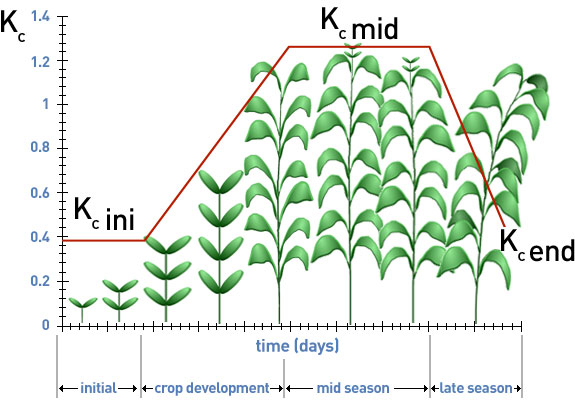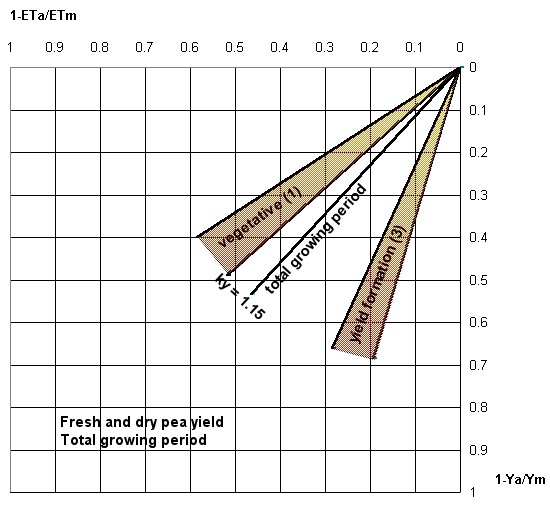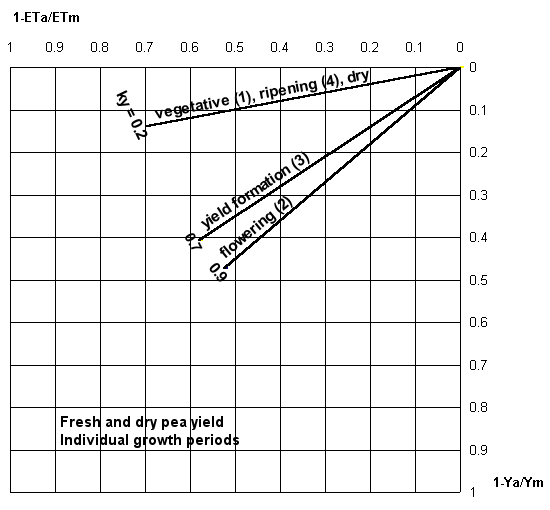Pea (Pisum sativum) is grown as a vegetable crop for both fresh and dried seed. Present world production is about 10.5 million tons dry pea and 7 million tons fresh pea.(FAOSTAT, 2001).
The varieties range from tall climbing to small bunch types with the latter having a shorter growing period. Pea is a cool climate crop and optimum mean daily temperature is 17°C with a minimum of 10°C and a maximum of 23°C. Germination is affected by soil temperature; at 5°germination takes 30 days or more, at l0°C about 14 days and at 20 to 30°C about 6 days. Young plants can tolerate light frost but flowers and green pods are injured by light frost. In the tropics near the equator, peas are grown at about 1500 m altitude, or as a winter crop in areas away from the equator. The normal growing period is 65 to 100 days for fresh pea with an additional 20 days for dry peas. The growing period is extended under cool conditions.
The crop does well on most soils with good drains e and pH of 5.5 to 6.5. Fertilizer requirements are about 20 to 40 kg/ha N, 40 to & kg/ha P and 80 to 160 kg/ha K. Pea is capable of fixing atmospheric nitrogen, which meets its requirements for high yields. However, a starter dose of 20 to 40 kg/ha N is beneficial for good early growth.
Pea is sensitive to soil salinity with yield decrease at different levels of ECe similar to that of bean, or 0% at ECe 1.0, 10% at 1.5, 25% at 2.3, 50% at 3.6, and 100% at ECe 6.5 mmhos/cm.
Plant spacing depends on variety and type and whether bunch or climbing, and is between 0.6 to 0.9 x 0.05 to 0.1 m with a wider spacing when grown along with stakes. Depth of sowing is 2 to 5 cm. Prevention against root rot requires good drainage and rotation. Common rotation crops are alfalfa, potatoes and sugarbeet.
The graph below depicts the crop stages of pea, and the table summarises the main crop coefficients used for water management.

Stages of Development | Plant date | Region | |||||
|---|---|---|---|---|---|---|---|
Crop characteristic | Initial | Crop | Mid- season | Late | Total | ||
Pea-dry | |||||||
Stage length, days | 15 | 25 | 35 | 15 | 90 | May | Europe |
Depletion Coefficient, p | – | – | – | – | 0.4 |
| |
Root Depth, m | – | – | – | – | 1.0 |
| |
Crop Coefficient, Kc | 0.5 | >> | 1.15 | 0.3 | – |
| |
Yield Response Factor, Ky | 0.2 | 0.9 | 0.7 | 0.2 | 1.15 |
| |
Pea-fresh | |||||||
Stage length, days | 15 | 25 | 35 | 15 | 90 | May | Europe |
Depletion Coefficient, p | – | – | – | – | 0.35 |
| |
Root Depth, m | – | – | – | – | 1.0 |
| |
Crop Coefficient, Kc | 0.5 | >> | 1.15 | 1.1 | – |
| |
Yield Response Factor, Ky | 0.2 | 0.9 | 0.7 | 0.2 | 1.15 |
| |
Water requirements (ETm) of pea are similar to bean (350 to 500 mm). The crop coefficient (kc) relating maximum evapotranspiration (ETm) to reference evapotranspiration (ETo) is: during the initial stage 0.4 (10 to 25 days), the development stage 0.7-0.8 (25 to 30 days), the mid-season stage 1.05-1.2 (25 to 30 days), the late-season stage 1.0-1. 15 (5 to 10 days) (fresh) and 0.65-0.75 (20 to 30 days) (dried), and at harvest 0.95-1.1 (fresh) and 0.25-0.3 (dried).
The relationships between relative yield decrease (1 – Ya/Ym) and relative evapotranspiration deficit for the total growing period are shown in the figure below.

This figure shows the relationships between relative yield decrease (1 – Ya/Ym) and relative evapotranspiration deficit for the individual growth periods.

The growing periods of pea are:
Crop stage | Fresh | Flower | |
|---|---|---|---|
0 | establishment | 10-15 days | 10-15 days |
1 | vegetative | 25-30 | 25-30 |
2 | flowering (including pod set) | 15-20 | 15-20 |
3 | yield formation (pod development and bean pod) | 15-20 | 20-25 |
4 | ripening | 0-5 | 15-20 |
Total | 65-100 days | 85-120 days | |
The sensitive periods for water deficits are flowering (2) and yield formation (3). Unlimited water supply during the vegetative period (1) increases vegetative growth but may not necessarily affect the pea yield; water deficit in this period has a relatively small effect on yield. Similarly, water deficit during the ripening period for dry peas has a small effect on yield.
When rainfall is insufficient, irrigation during the flowering period (2) increases the number of marketable pods and number of seeds per pod, and during the yield formation period (3) increases the weight of both pod and seed. The crop tends to wilt more readily during periods of water shortage when adequate water was avail-able in the preceeding periods.
For high yields the soil water depletion should not exceed 60 percent of the total available soil water during the vegetative period (1), and 40 percent during flowering (2) and yield formation (3) periods. Too frequent and light irrigation application results in uneven ripening. With harvest consisting of one picking it is some-times recommended to withhold water supply during the latter part of the yield formation period (3) to advance ripening of the most developed pods. This applies particularly to varieties with a long and non-uniform ripening period.
Under conditions of limited water supply a high total production is obtained by meeting full crop water requirements on a limited area rather than by extending the area and partially meeting crop water requirements.
The crop has a tap root with many thin laterals. Rooting depth in deep soils can extend to 1 to 1. 5 m but the effective depth of water uptake is generally restricted to the first 0.6 to 1.0 m (D=0.6-1.0m). The uptake pattern over soil depth, however, depends greatly on the irrigation practices. The uptake of water in relation to ETm is little affected up to soil water depletion of about 40 percent of total available soil water (p = 0.4).
For optimum yield levels the soil water depletion in most climates should not exceed 40 percent of the total available soil water and irrigation frequencies of 7 to 10 days are common. When water supply is short, irrigation should be adequate during the flowering (2) and yield formation (3) periods with possible savings during the vegetative (1) and ripening (4) periods. When frequent irrigation is not possible, water supply should be scheduled as pre-irrigation, at flowering (2) and at the yield formation period (3) respectively, or with one irrigation only at least about 40 to 60 days after the pre-irrigation.
When irrigation is irregular, pods and seeds are less uniform in size, more variable in colour and also the date of maturity will vary. A high water deficit during late yield formation results in tough seeds of poor quality. In general, increase in seed size is accompanied by a decrease in the sugar content and the tenderness of the seed, and an increase in the starch and protein contents. Correct timing of the harvest remains an essential requirement for a good quality product. In suitable climates, good yields under irrigation are between 2 and 3 ton/ha shelled fresh pea (70 to 80 percent moisture) and 0.6 and 0.8 ton/ha dry pea (12 percent moisture). The water utilization efficiency for harvested yield (Ey) for fresh pea is about 0.5 to 0.7 kg/m3 and for fresh pea about 0. 15 to 0.20 kg/m3.
